#mesoglea
Explore tagged Tumblr posts
Text

The Science Research Notebooks of S. Sunkavally. Page 317.
#MSG#calcium deficiency#obesity#particulates in air#fibrinogen#insomnia#macrophages#glycolysis#hydra#mesoglea#Red Sea#speciation#salt concentration#lymph nodes#frog#length of intestine#bony fishes#swim bladders#blue-green algae#mitochondria#sonic vibration#cryptobiosis#satyendra sunkavally#theoretical biology#manuscript#notebooks#diaries#cursive handwriting
1 note
·
View note
Note
So like, what IS the best way to kill a dragon, then?
Gryfon or the ground teams harpoon it and drag it to the ground using a mechanical winch, everybody else just gets to cutting and mauling until it stops moving. It's not very sophisticated but due to the sheer size of the dragon and the fact that it appears to have no weak spots (i.e a place you can stab to kill it in one hit) it's still very difficult and can take weeks at a time. Because the dragons are hosts to hives of small flying pterosaur-like cetaceans, a lot of the battle is just killing or capturing those guys, as they attack anything threatening their dragon indiscriminately
#the mesoglea is also surprisingly dense for something that's basically just a horrible jelly#a person on the ground would not be able to damage ilthe cuticle with a sword or small gun#but cannons are considered a little too dangerous because they can easily shoot through the wrong part and spill the ichor#setting: mez
119 notes
·
View notes
Text
UNDER THE WATER. } yuta okkotsu . . .
ꖛ summary * an aquarium date with your nerdy boyfriend.
ꖛ warnings! * fluff + sfw college au, photographer yuta ! he's a nerd over marine animals, and you love it ! a lot of stupid facts about jellyfish ! yuta is 20, reader is 21 in this (although nothing happens) ! NOT PROOFREAD.
ꖛ about. * reader is gender-neutral. no anatomy specified + they/them pronouns and genderless nicknames.
ꖛ author's note * this feels really rushed but sighhhhh. just had the idea and wanted to write it down. i hope it's not bad for a first post here. english is not my first language, so i apologize for any mistakes.
ꖛ word count 899.

some say that love at first sight is nonsense, but yuta and you have a beautiful variation of this cliché: love at first click. you can still remember his surprised expression when he took the first picture of you. it was simple, an okay request. he needed a model to sit on campus to test the new camera. and then click. one photo became three, and he complimented your physique a lot.
nervous stuttering of calling you photogenic evolved into asking you to be his model more often — until you took the first step to ask for his number. and a year later, you two stand strong: walking down the aquarium while holding hands.
“oh, yeah— and jellyfish have no brains, hearts, or lungs! they’re very simple organisms, actually.” yuta rambles, pointing to one of the little creatures in question, which simply swims without thinking about much. it is surprising that apparently such thin glass can support such a large amount of water.
you nod slowly, hearing every word with the utmost attention, because, really, how could you not? he's usually so shy and speaks so little around other people, but at home or with you, he can just talk about his extremely nerdy interests. it was one of the things that brought you two closer, in fact. (although, it would have been better if he flirted back instead of rambling about the structure of a camera that one day…)
“so, how are they built like?” you ask, already knowing (superficially) that jellyfishes don’t actually have any of these organs. you just want to hear that gentle, smooth voice with a hint of excitement break it down to you.
yuta smiles so widely, as if he couldn't be happier that you asked. so cute, you think.
“okay, okay. think about it.” he lets go of your hand for the smallest of moments, to gesture as he explains — pouting for a second. but it is for the greater good of getting you to understand the biology of jellyfish. “their bodies are made up of just three layers— the outer epidermis, a gelatinous middle layer called the mesoglea, and the inner gastrodermis.”
again, you nod along to his explanation — even if now you're more focused on the cute way his fingers move to draw the patterns in the air more than the words themselves. but you can't resist the opportunity to make a joke.
“layers? like onions?”
“no, love, not like onions—” he sighs, almost sounding disappointed by your comparison. he pouts like a bunny about to throw a tantrum and stomp the ground furiously. you can't help but laugh at the way his lips curve, and you grab his wrist for an apology.
you bring his hand up to your mouth, kissing the back of it slightly. it always makes him red in the face, and he cups your cheek softly, trying to keep you close.
“okay, not like onions. got it.”
yuta huffs slightly — murmuring something about accepting your mistakes — before he goes back to rambling. however, now you are lost in thought. jellyfish have an elementary nervous system with receptors that detect light, vibrations, and chemicals in the water. Along with the ability to sense gravity, these capabilities allow the jellyfish to navigate... it all goes over your head as you think: how did you two get here? from small texts and giggles, to letters and home dates. to stargazing to kissing, and so much more—
“love?” he asks, more worried than upset. “you’re silent. are you alright?” yuta is quick to reach for your hand again, his dark blue eyes reminding you that he is prettier than the ocean. soft, gentle and warming as a bonfire, but calm and fluid as the water.
“yes. just thinking about how much i like hearing you talk about stupid fish.”
he gasps dramatically, pretending to be offended. “just for you to know, despite the name, jellyfish are actually cnidarians, which are a type of invertebrate—”
before he can ramble any longer, your fingers detach from his, and both of your gentle hands come up to grab him by the cheeks. yuta would protest, but soon your lips are glued to his, and his brain melts.
all information about any kind of marine animal just disappears, and you are all that is left on his mind. the taste of your lips, the smoothness of your hands, the prettiness of your eyes. you, you, you.
you lean back, giving him that little smirk that tells the poor man you know exactly what you just did. you threw him off his feet.
“what were you saying, yuta? about— cnidarians?”
“i—” he sighs, smiling softly and muttering a what am i going to do with you under his breath. “i don’t actually remember.”
you chuckle, kissing his cheek and wrapping your arms around his shoulders. yuta bumps his nose against yours gently, and you hear someone complaining about young couples nowadays have no shame.
“what do you want to see next?” he asks lovingly.
“let’s take a look at puffer fish.” you mutter back, giving a small peck to his lips before pulling away. he smiles excitedly, going back to his rambles.
“oh, did you know that adult puffer fish have just four teeth, fused together into one strong beak? they use this to open clams or mussels, and scrape algae off rock—”

© made by spiralryomen on tumblr. do not copy, repost, translate my works in this or any other side — inspirations allowed with credits.
#☆ styx flows!#yuta okkotsu#jujutsu kaisen x reader#okkotsu yuuta x reader#yuta x reader#yuta okkotsu x reader#yuta okkotsu x you#yuta okkotsu x y/n#yuuta okkotsu x reader#yuuta okkotsu x y/n#jjk x reader#jjk x you#jjk x y/n#jujutsu kaisen x you#jujutsu kaisen x gender neutral reader#jjk fluff#jujutsu kaisen fluff#jjk fanfic#jujustsu kaisen x reader#jjk x gender neutral reader
288 notes
·
View notes
Text
Wet Beast Wednesday: comb jellies
It's ctime for another post about aquatic critters. Ctoday I'm ctalking about the cterrific ctenophores. This ctimeless lineage of gelatinous invertebrates may hold answers about the origin of animals cthemselves. So from ctiny to ctitanic, lets go over the comb jellies to ctell their ctale.
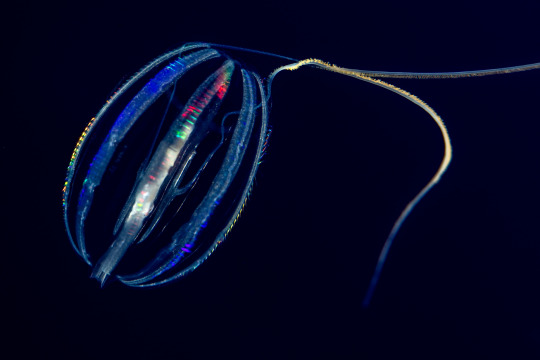
(Image: a cydippid comb jelly. It is a round, mostly translucent animal with few visible structures. Rows of combs made of cilia run down its side and appear rainbow-colored due to light scattering. Two sticky tentacles trail behind it. End ID)
The comb jellies are members of the phylum Ctenophora. There are between 100 and 200 known species. The ambiguity is because several species have been mistakenly been named more than once. That's pretty small for a phylum, but the comb jellies have some pretty diverse body plans. Ctenophores are fairly simple animals, that have some shared traits with the cnidarians, though they are not believed to be closely related. Ctenophores are round animals that, like the cnidarians, have bodies composed of two layers of cells sandwiching a gelatinous matrix called the mesoglea. One side of the body has a mouth that opens into a large internal body cavity via the pharynx (throat). The cavity acts as a stomach and connecrs to canals that run to other parts of the body. Also in the cavity are cells for reproduction, digestion, and bioluminescence. On the outside of the body are rows of cilia called combs that run from the mouth to the back. The cilia beat in sequence from mouth to rear to propel the ctenophore forward, though they can also be reverse to move it backwards. Most ctenophores have tentacles that are lined with sticky structures called colloblasts that are used to capture prey. Prey is drawn through the mouth and pharynx into the main body cavity where muscular action and digestive enzymes break it down. Unusable food is ejected back out through the mouth.
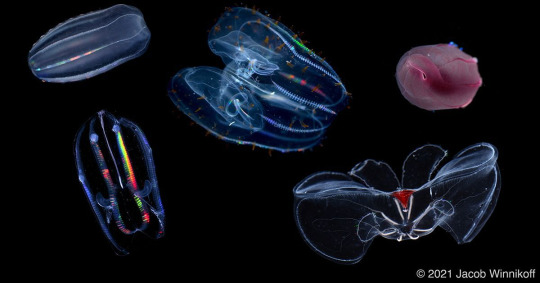
(Image 5 different species of comb jelly with different body plans. Some are rounded, others and longer and flattened, One has two large lobes, and one is splayed open. End ID)
Comb jellies have a primitive nervous system consisting of nerve nets with no brain. Unlike the nerve nets of other animals, which are connected by synapses, ctenophore neurons are fused together into a structure called the syncytium. There are two nerve nets, one focused around the mouth that controls the sensory organs, mouth, pharynx, and comb rows. A second nerve net is focused around the aboral organ, which lies opposite the mouth. This organ contains a structure called a statocyst that regulates balance and helps the ctenophore determine which direction to swim in. The nervous system uses different biochemistry than any other animal. This could indicate that ctenophores developed a nervous system independently of other animals, indicating they may be a sister group to all other animals. More on that in its own paragraph. The genome that codes for the nervous system is the smallest of any animal and may be the absolute minimum needed to have a functional nervous system.
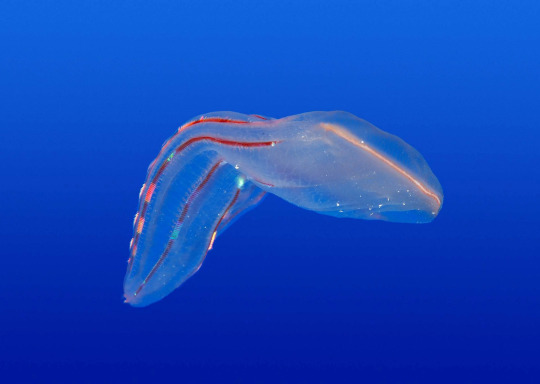
(Image: a long, flattened beroid ctenophore. Its mouth is very wide and runs along most of the front of its body, It has no tentacles. End ID)
Comb jellies have a large number of different body plans, with three being particularly common: the cydippids, lobates, and beriods. Cydippid comb jellies have very rounded bodies with a pair of long tentacles that are lined with colloblasts. The jellies drag the tentacles through to water to trap small invertebrates and plankton for consumption. Lobates have large muscular extensions called lobes that extend beyond the mouth and their tentacles line the inside of the lobes instead of trailing behind them. Cilia direct water into the lobes where the tentacles catch planktonic prey. The beroids are the only comb jellies without tentacles. Their bodies are flattened and their mouths are extremely large and line with thick cilia that act like teeth. Beroids are pursuit predators that hunt other ctenophores by either swallowing them whole or using their "teeth" to bite off chunks.
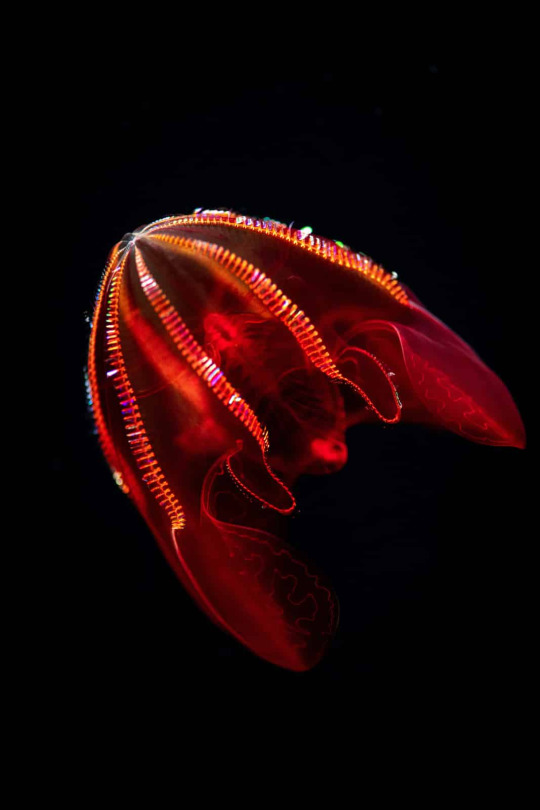
(Image: Lampocteis cruentiventer, the bloody-belly comb jelly, a lobate. Its body is red and a pair of scoop-shaped lobes extend on either side of the mouth. End ID)
Other, less common body plans include the ganeshids (who have lobes like the lobates, but the pharynx extends into the lobes and they use tentacles for hunting), the thalassocalycids (who have developed a body plan and hunting style more like jellyfish. Only one species is known), the cestids (who have very long, ribbon-like bodies and short tentacles that swim by undulating like an eel. The largest comb jelly, Cestum veneris or Venus's girdle, is one of these can can reach 1.5 m/5 ft in length), and the platyctenids (who have modified their pharynxes into structure similar to a snail's foot and live on the seafloor or in symbiotic relationships with other invertebrates. They lack combs and cannot swim).
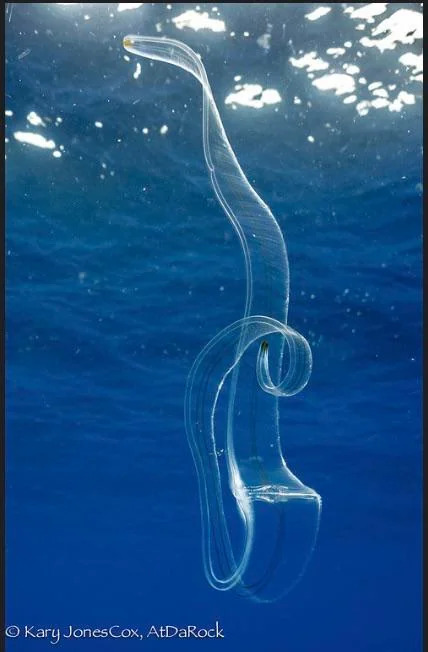
(Image: a Venus's girdle. It is a flat and very long comb jelly that looks more like a transparent flatworm than a comb jelly. End ID)
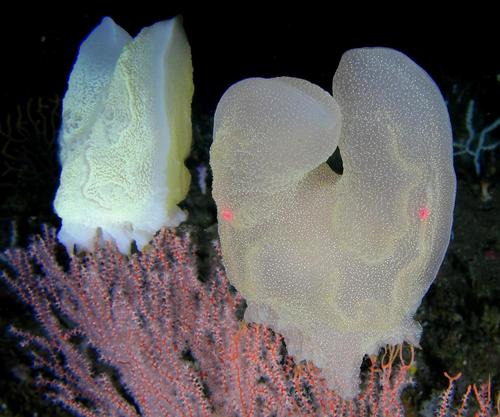
(Image: platyctenid comb jellies on a coral. They are whitish, bag-like animans with U-shaped bodies and mouths that open down and have extended organs used as feet emerginf from them. They have no combs. End ID)
Most comb jellies are hermaphroditic, with some species being simultaneous hermaphrodites (produce sperm and eggs at the same time) and other species being sequential hermaphrodites (transition between the types of gametes they produce). Three known species have evolves distinct sexes. Most simultaneous hermaphroditic species can self-fertilize. Eggs and sperm are released into the water column to fertilize. Juveniles look like miniature adults and do not go through a larval stage. The platyctenids have different reproductive behavior. Their eggs are retained in an internal brood pouch until they hatch. Juvenile platyctenids are planktonic and will go through a metamorphosis where they transition into their bottom-swelling adult forms. Platyctenids are also capable of asexual reproduction by budding off clones of themselves. Many species are capable of producing gametes as juveniles, become infertile as they mature, then begin producing gametes again as adults. Ctenophores will continuously produce gametes as long as they have enough food.
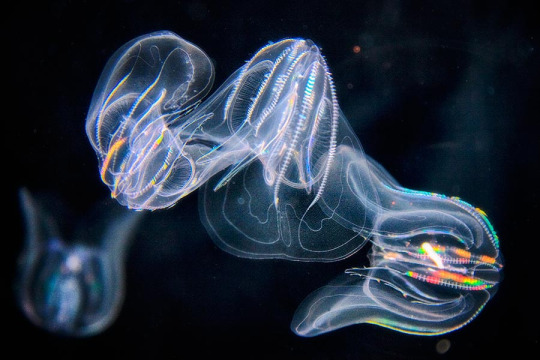
(Image: a group of lobate ctenophores. End ID)
There is some debate on where exactly comb jellies fall in the tree of life. Specifically, the debate is about how they relate to other animals. Historically it has been thought that animals were divided into the sponges on one side and and metazoans (everything else) on the other side because sponges lack certain features found in all other animals like a nervous system, sense organs, and muscles. Ctenophores were often placed as sisters to the cnidarians (jellyfish, anemones, and other radially-symmetrical animals) and bilaterians (bilaterally symmetrical animals). The placozoans (simple animals that consist of a blob of cells) were placed either on the sponge side, metazoan side, or their own group depending on who you asked. More recently, there has been a shift to grouping the sponges and placozoans with the metazoans as all being a sister group to the ctenophores. That would make ctenophores the sisters to all other animals. Genetics makes my head hurt but it appears that the data is inconclusive and there's still a lot of debate to be had. The fact that soft bodied animals like comb jellies rarely fossilize makes things harder as it means we only have a very small number of fossils to examine. Finding out where ctenophores fall in relation to other animals would answer a lot of open questions about the evolution of the first animals.
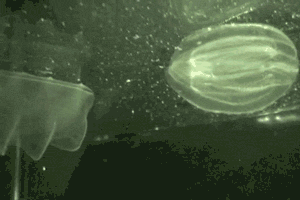
(GIF: A beroid comb jelly eating another comb jelly. The two bump into each other and the beroid opens its mouth and engulfs the prey. It then closes its mouth, trapping the prey in its body cavity. End ID)
#wet beast wednesday#comb jelly#ctenophore#jellies#invertebrates#invertblr#invertiblr#marine biology#biology#zoology#ecology#animal facts#sea creatures#informative#educational#image described
124 notes
·
View notes
Text
Round 1 - Phylum Cnidaria




(Sources - 1, 2, 3, 4)
Cnidaria is a phylum of aquatic animals which includes the Anthozoans (sea anemones, corals, sea pens), the Scyphozoans ( true jellies), the Cubozoans (box jellies), the Hydrozoans (a diverse group ranging from Hydras to the colonial Portuguese Man O’ War), the Staurozoans (eight-tentacled cnidarians that cling to seaweeds and rocks), and the parasitic Myxozoans and Polypodiozoans.
Cnidarians are identified by a decentralized nervous system distributed throughout a gelatinous body, and specialized explosive stinging cells, called cnidocytes, on ejectable flagella (“tentacles”) which are used to envenomate prey ranging from plankton to animals several times larger than themselves. Their bodies consist of a jelly-like substance called mesoglea sandwiched between two thin cell layers. Cnidarians are some of the only animals that can reproduce both sexually and asexually.
Many species of Cnidarian are actually groups of polyps, called zooids, clustered together to form one collonial organism. Corals, the Man O’ War, and Siphonophores are examples of this.

Propaganda below the cut:
Corals support 25% of all ocean life
Reefs are formed when coral polyps group together and produce a skeleton of calcium carbonate at their bases. They do this to form a platform that allows them to better stick together.
In a relationship that dates back to the Triassic, the symbiotic algae that live within corals gives them their colors, as well as creates nutrients for both organisms
Corals are facing a mass extinction due to climate change
While anemones are mainly sessile, usually staying in one place for weeks to months at a time, they can creep along on their bases at a speed too slow to be seen with the naked eye. However, some species can move or “swim” quickly in a pinch. Gonactinia can crawl like an inchworm, Paranthus rapiformis can curl into a ball and roll around, and Stomphia coccinea can swim by flexing its column. They just look really silly doing so.
Anemones are predators, stinging prey and pulling it into their mouth with their tentacles. They can eat animals as large as crabs, mollusks, and even small fish. However, some fish and invertebrates have a symbiotic relationship with anemones. Immune to the anemone’s venom, these animals utilize it as shelter while keeping it clean and providing it with nutrients from their feces. Some hermit crabs even carry anemones on their shells, providing the anemone with quick transport to new areas in return for protection.
Box Jellies have simple eyes, are capable of pursuing and reacting to prey behavior, and some species are some of the most deadly animals in the world.
The Lion’s Mane Jelly (Cyanea capillata) is one of the largest jellyfish, with the largest recorded specimen having a bell width of 210 cm (7 ft) and tentacles around 36.6 m (120 ft) long.
The Lion’s Mane Jelly is also the favorite food of Leatherback Sea Turtles.
A rise in jellyfish population can signify ecosystem collapse
The Giant Siphonophore (Praya dubia) is a collonial Hydrozoan that can get up to 50 m (160 ft) long, rivaling the Blue Whale in length.
Some Cnidarians can “hear” via vibrations, and some can even produce sounds to communicate
Many Cnidarians are bioluminescent
132 notes
·
View notes
Text

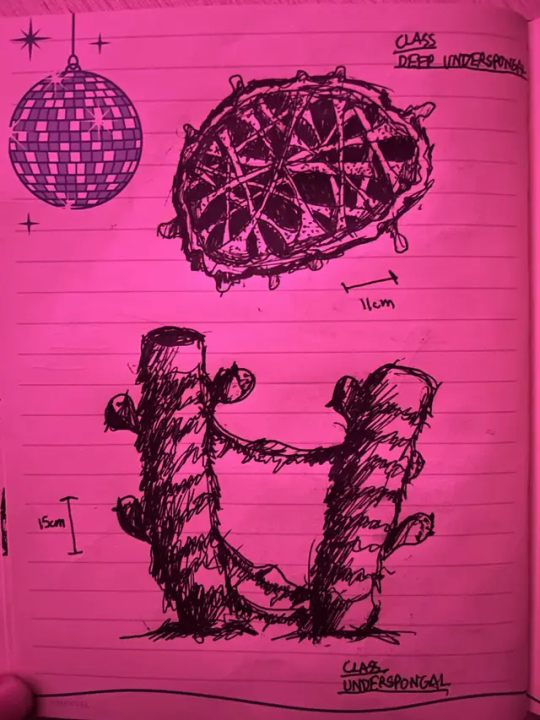
Next up on our alien animals, the Sponges !!!!
Of which there are MANY MANY MANY on Jom'Gol... the entire planet was once covered by sponges for nearly 1 billion years in its early history....
(AN1 C2) Clade: Spongae
A clade of asymmetricans that have internal, flexible skeletons made of spongin fibers.
PHYLUM DEEPSPONGAE
Phylum of sponge existing in the lower stratification of the marine biosphere, containing a pseudo-hemocoel and porous membrane.
(AN1 C2-a) Clade: Fossospongae
A clade of sponge that rely on ambient environment temperature and have small mesohyl nodes within sponge structures.
(AN1 C2-ai) Clade: Saltuspongae
A clade of fossospongae that thrive in salt-rich and copper-rich environments within the lower stratification of the marine biosphere.
Class Seafloor Spongeforest
Class of colonial sponge that organize into massive forest-like hives on the seafloor with other members of the same class.
(AN1 C2-b) Clade: Hadeospongae
A clade of sponge that have large mesoglea organ tissues to regulate pressure and contain biological antifreeze agents to regulate core temperature.
Class Abyssal Sponges
Class of sponge that exist in ocean trenches and deep marine fissures in the abyssal and hadal zones of the ocean.
Class Deep Underspongal
Class of sponge that are strictly stygofauna and live in brackish subterranean waters within aquifers, deep flooded caves, and some vugs.
(AN1 C2-c) Clade: Fractospongae
A clade of sponge that relies on a branching hemocoel to deliver nutrients to areas of the sponge not able to reach food.
(AN1 C2-ci) Clade: Underspongae
A clade of fractospongae that use entirely chemical synthesis for ectothermy and navigation rather than light.
Class Underspongal
Class of sponge that are troglofauna and frequently line low-pressure cave systems and non-brackish pools of cave water.
#art#artists on tumblr#worldbuilding#jomgol#spec bio#spec evo#speculative biology#speculative evolution#traditional art#traditional sketch#alien#alien species#xenobiology#speculative zoology#creature design#creature
47 notes
·
View notes
Note
@nautilus-that-eats-hyacinths (just tagging them BC of the cephalapods think nothing of it)
AFOOZ I JUST REALIZED WHY I CALL STUFFED ANIMALS STUFFIES!!!!

I spent a considerable amount of my childhood in Canada AND IM PRETTY SURE "STUFFY" IS LIKE THE NORM THERE (this picture was taken at the Vancouver Aquarium but STILL)
I think I spell it like stuffie most of the time tho, it's cuter that way imo
okay that makes sense. canadians are weird (tho stuffie is the Correct Term and canadians are usually Correct)
my mom and i were talking the other day and we realised that most of my siblings say "'not i!' said the cow" in response to being asked if anyone could do things because SHE does it all the time and we must've picked up on it during our childhood. i figured for a while that i just said it cuz i was read that book several times in elementary school, but i am pretty sure that my mom rubbed off on me too. in a similar vein, my mom sometimes says "home again, home again, jiggity jig" when we arrive home after a long car trip and i never thought much of it, but she told us that apparently her mom would say it when she was a child and she and my aunt figured out only a few years ago that that rubbed off on them.
i think it's interesting to find where stupid words and phrases and parts of our dialect come from
#HAAH it rly is cool isn't it???#We've got a couple of things like that in my family but they mainly come from inside jokes#Like Just asking ''can I have the rest?'' for literally anything has become funny because of something my brother did like 4 years ago#Hummm I should probably think about this more though because a lot of my vocabulary is actually influenced by my friends rather than family#The only lil thing I can think of is all the terms I use that are jellyfish related#Medusoza. Mesoglea. Fluther. Jestie. Those kinds of things haha :)#YEAH SQUIB
9 notes
·
View notes
Text
Animalnomenon of the day: Jellyfish!
Jellyfish are usually known as transparent floating blobs with tentacles on the ocean, but did you know, not all of them have tentacles? For example, the deepstaria enigmatica has no mouth-arms or tentacles at all!
There is a kind of "immortal" jellyfish! The Turritopsis dohrnii can't die due to old age, once it gets old or hurt, it'll drop to the seabed and use transdifferentiation to get its former cells from when it was still a polyp back, making these animals biologically immortal!

A jellyfish's size can vary a lot! For example, some jellyfish, like the irukandji, can be as small as a coin, but some can grow to be around the size of a 13 story building, like the lion's mane jellyfish.
They're made of mostly water! Since they are around 95% water, most jellyfish evaporate a few hours after being washed ashore.

Jellyfish have no brain, heart or bones, they're very simple animals and only have 3 layers, the outer epidermis, the mesoglea, and the inner gastrodermis, but although they may not have a brain or a heart, they have an elementary nervous system able to detect light, vibrations, and chemicals on the water.
They're a really old animal, it's estimated jellyfish have been around for over 500 million years, making them the oldest multi organ animal in the world, older than sharks, dinosaurs, and trees!

That was today's animalnomenon!
9 notes
·
View notes
Text
I hate to disappoint anyone who watched spongebob as a kid and thought jellyfish jelly looked tasty but their jelly (called mesoglea) is roughly 96% seawater so it's actually very salty. Though I guess plenty of people eat vegemite and pretend it tastes good so maybe some of you freaks would still enjoy it.
2 notes
·
View notes
Text
First & Last Sentence Tag War
So it has been a long time since I did one of these! Thanks for tagging me @ablatheringblatherskite!
I'm still working on chapter 4 of You Want Battle? (I'll Give You War), I'm 5k in and still not done. Hope it will be ready somewhere this week but here is a little preview.
First Sentence:
"I've got so many plans for you." The fear that crossed Laurel's face when Wednesday told her that was delicious. She had two centuries to plan her revenge on this woman and the moment was finally there. The Undine felt the power rushing through her, the return of her sealskin releasing her from the trap Laurel had put her in.
Last Sentence:
The Undine rose to her knees, Tyler slipping out of her as she did so. She immediately felt empty, her walls clamping down on nothing. Here she was, feeling like her whole body was made of the jelly-like mesoglea and yet her body was still begging for more. Jellyfish wished they could feel as relaxed as Wednesday did right now, body full of mating pheromones.
Tagging back: @justonemorewallflower @beri-allen @persephoneed @ourdramaqueen @nonamemanga @leavesdriftinginthewind @cupoteahatter
#tag war#wyler#weyler#wednesday netflix#ao3 fic#tyler galpin#wednesday#faeries#fae#selkies#myths#mythical creatures
18 notes
·
View notes
Text
Hello aro-spec jellyfans, do I have a hot new label for you:
Fluther("Fl-other"): An outdated, out of use term for a group of jellyfish 🪼
I propose a new meaning of the word to mean a friend, but one that you feel comfortable enough to bully the Mesoglea out of. Like a platonic relationship but just really comfortable, tbh
Tagging all my fluthers:
@tomnookishot @iskeletoncloset @tinybeeps @imgayforjimbotnik @audinoplushie @mirage-forest @volos-wish @slightlyplant
#Half of this list is just the people from pokepreciation and that's ok#If our relationship is not characterized by mutual and playful bullying then we are jesties#Anyways fluthers are also jesties#And#Omg anyways if I call you a fluther now you know what it means#mun rambles#jellyfish#actually aromantic#Idk if I should tag as ace too hmmm
23 notes
·
View notes
Note
How does Leun’s nitrohydrochloric acid weapon work?
Hiii
Aqua regia needs to be mixed up fresh each time it's used. So what happens is that within the throat area there's two compartments, one for nitric acid one for hydrochloric acid. The knight captain is aware of the goings on inside the body of the beast via his dialogue but does not actually control many of the systems - the knight gives an order from the cockpit using a pull-rope which is coloured alternating black and white. It is connected by a pulley system to the throat, where the people in there see the colour shift from black to white. That's how they know the knight has requested the breath weapon.
So these guys in the throat then release the nitric & hydrochloric acid. Each tank is already pre-filled with the right ratio to produce nitrohydrochloric acid which comes out very hot. The pressure of the spray can be controlled using hand-operated air pumps. I haven't decided how much acid we get per spray but it's enough for a few seconds of sustained spray. Then when that's done, the spent tanks are removed from their holsters and new tanks are brought forwards. It takes maybe thirty seconds of prep between sprays so they usually aren't used continuously, but as short strategic bursts.
Needless to say this process is injurious to the users almost 100% of the time. The fumes alone are horrific and if communication between stations within Leun breaks down, the spray could be discharged into a headwind.. sending it straight back against Leun's front, into the knight's chamber, the joints, or back at the unlucky acid makers. However the benefits outweigh the risks set by Pantera's flame breath, which produced so much smoke upon impacting the 99.9% water mesoglea of a dragon that it just wasn't worth it. The acid burns better than fire, in all weather, and without the smoke
124 notes
·
View notes
Text
Starfinder Themed Augmentations
I’ve been browsing the augmentation options in Starfinder. They’re kind of fascinating and occasionally horrifying, and it’s a fascinating subsystem to have available for a character, enabling them to in-universe customise their own bodies. If you have a paranoid asteroid miner from the Diaspora, they can give themselves pressurised lungs as an emergency backup in case of decompression. If you have an envoy with a spooky vibe, they could go for a vampire voice necrograft to get a threatening edge. Or if you have an expressionistic artist who’s fascinated by light, they could go for a bioluminescent skin and an angler’s light. And those are just some basic options. There’s room to go a LOT more extreme, if you’ve got credits and room in your body. Some are useful, some are less useful, but it fascinating that they’re an option.
So. Some ideas for themed sets of augmentations, if you character wants to pursue specific bodily ideals. For reasons, perhaps not all of them sane. Heh.
Tentacle Monster
Paranoid Spacer
Performance Artiste
BioTitan
Tentacle Monster
First and weirdest, but I love that this is honestly something you can pursue. If you want a character who gradually turns themselves into a tentacle creature, that is 100% doable. If you want to be a cultist from Aucturn who wants to modify themselves in honour of the outer gods (or a devotee of Oras with similar ideals), there are options. Particularly from the biotech augmentations tree, and one from the necrograft tree too. Unfortunately, a lot of them live in your spine, so you’ll have to pick and choose, but if you choose the biotechnician theme you can get an extra one at 12th level (or take the Augmented archetype to get it at Level 4).
So. Some tentacular options to pick up: Slimelashes (lvl 4, Hands), for little ‘protoplasmic tendrils’ that you can shoot out of your hands to snatch unattended objects, Mesoglea Tentacles (lvl 4, Spine), for a cloud of wavering jellyfish tendrils extending from your back that you can wrap in tight for 1 minute for a bit of slashing resistance and the ability to sting melee enemies, Healing Tendrils (lvl 3/7/9/13/16, Spine), for a translucent tendril you can send out to heal people and a few other things, Grasping Tentacle (lvl 6, Hand/Arm), where you turn one of your arms into a tentacle for some extra reach and a bonus to combat manoeuvres, Unity Tendril (lvl 6/10/14, Spine), for touch telepathy via spinal tentacle, Mobility Tentacles (lvl 8, Legs/Feet), where you replace your lower limbs with 4 tentacles to gain built in climb/swim speed, and, from the Necrograft tree, Squirming Entrails (lvl 1/6/12/18/20, Throat), where you line your throat with writhing entrails that bolster your digestion and can be extruded from your mouth to act as auxiliary limbs.
Personally, if you were going for the full visual tentacle experience, I’d go for Squirming Entrails, Slimelashes (grasping tentacle just makes it feel unbalanced, unless you were getting two, and I think I’d like to keep both opposable thumbs and the ability to shoot little tentacles from my hands), Mobility Tentacles, and your favourite of Healing Tendrils/Unity Tendrils/Mesoglea Tentacles. Mesoglea Tentacles gives much more visual impact, but less utility, but if we are going for the visual, this character wanted to be a tentacle monster, then I’d go for them first. If you have biotechnician or some other means of picking up multiple biotech augments in the same system, I’d pick Mesoglea and Healing Tendrils, myself.
So now by level 8, if you got them as soon as they became available, you have tentacles for legs, writhing jellyfish tendrils drifting out from your spine, little tentacles you can shoot from your hands, and horrifying tentacly entrails you can shoot from your mouth, plus maybe a healing or telepathy tentacle you can also extrude from your spine. Nyarlathotep and/or Oras are very pleased.
Paranoid Asteroid Miner/Colonist/Vaster/Spacer in General
Redundancy is the key to survival. This was the mantra beaten into your brain from day 1. Vacuum and other environmental dangers lurk only a thin skin of metal away at all times. Plan for system failures. If your bedroom is vented out into the vacuum in the morning, with you naked and asleep in it, try and see to it that you have means to survive.
This is that character who runs numbers on scenarios like ‘if the sleeping quarters on the station get hit and vented into space in the morning’ or ‘if I’m captured by enemies, stripped naked and thrown out an airlock or into a toxic wilderness’, how screwed am I? The sort of character who just wants all the survival augments, because you can’t always trust that you’ll be in armour or a spacesuit when the worst happens, or that your armour/space suit/ship/space station will remain intact.
So they look at options like Pressurised Lungs (lvl 1, Lungs), Cold Inured Graft (lvl 1, Skin), Withered Lungs (lvl 1/6/12/18/20, Lungs), Void Flyer Graft (lvl 4, Lungs & Spine), Regenerative Blood (lvl 5/8/12/15/19, Heart), Atmospheric Adaptation Graft (lvl 6, Lungs), Starhide (lvl 7, Skin), Personal Stasis Unit (lvl 9, Skin)/Stasis Gland (lvl 9, Spine), Stillheart (lvl 11, Heart), Superorgan (lvl 14/15/16/17/19, Brain Heart Lungs). Maybe even things like an Emotional Regulator (lvl 4, Brain), to control panic responses in a crisis.
Maybe they’ve seen habitat rings go down in station attacks, or they’ve lost buddies on space walks gone wrong, or they’ve heard horror stories of disabled starships and slow deaths, and they’re willing to spend credits on their paranoia to avoid it happening to them.
(Yes, sarcesians are one of my favourite species, and yes the Diaspora is one of my favourite settings, and yes, my paranoid little ysoki mechanic from the Farabarrium wants pressurised lungs and later void flyer just in case. Is her bedroom ever actually going to be vented into space, or a bunch of space pirates strip her naked and throw her out an airlock? Probably not, but you can bet she’s thought about it happening. Redundancy is the key to survival! Just because you’ve got environmental protections and armour doesn’t mean you shouldn’t plan for the worst anyway!)
Performance Artiste
For when you want body mods that are useful, yes, but also pretty, impressive, or themed around performance, captivation, allure. For the character who wants to be stunning, in more ways than one, and is willing to pay to achieve it. Also works were for certain types of spies/envoys. These are augmentations designed to make specific impressions on people, for good or ill.
(A lot of these live in your skin/throat/eyes, so pick and choose)
Bioluminescent Skin (lvl 1, Skin), Vocal Modulator (lvl 1, Throat), Vampire Voice (lvl 1/6/12/18,20, Throat), Angler’s Light (lvl 2, Spine), Skin Mimic Graft (lvl 2, Skin), Psychoactive Eyes (lvl 2/6, Eyes), Mighty Vocal Cords (lvl 3, Throat), Glass Skin (lvl 4, Skin), Resonant Larynx (lvl 6/11, Throat), Ultralight Wings (lvl 7/11/14, Arms), Enchanting Vocal Modulator (lvl 11/14/17, Throat)
(I love glass skin in particular, and that’s not because of invisibility, but because it comes from glass serpents, and it’s just a fantastic background worldbuilding detail)
BioTitan
Your body is a weapon. Your body is many weapons. You want to be the most lethal thing in the world to get close to. You absolutely cannot be disarmed, because you built your lethality into your bones. And skin. And throat. And a few other things. Nor have you neglected your defenses, either.
Options: Restraining Spinneret (lvl 1, Hand), Bone Blade (lvl 1/6/12/18/20, Arm), Enervating Hand (lvl 1/6/12/18/20, Hand), Stench Glands (lvl 1/6/12/18/20, Skin), Venom Spur (lvl 2, Hand), Sonic Vocaliser (lvl 2/7/11/16/20, Throat), Dragon Gland (lvl 2/10/26, Throat), Resistant Hide (lvl 2/4/7/10/13/17, Skin), Optical Laser (lvl 3/7/11/15/19, Eye), Rending Talons (lvl 4/8/12/16, Feet), Bone Spines (lvl 5/9/13/17, Spine), Acid Reservoir (lvl 5/12/19, arm or throat), Flametongue (lvl 5/9/13/18, Throat), Psychic Chatter (lvl 5/9/13/17, Brain), Dermal Plating (lvl 5/7/9/12/14/16/19, Skin), Adrenal Booster (lvl 8, Endocrine), Shock Fist (lvl 9/12/17/20, Hand), Superorgan (lvl 14/15/16/17/19, Brain Heart Lungs)
So if your character wants to pick up, say, a bone blade, a laser eye, acid breath and plated hide, as well as bolster their internal organs, and maybe pick up a cheap spider spinneret in their hand for when they need someone alive afterwards … Or a bone blade, bone spines and rending talons on their feet, for a general theme of spiky boi … sonic vocaliser and shock fist for a thunderous sort of experience …
Weaponising your body is absolutely an option in Starfinder.
Final Thoughts:
If you’re getting the impression that the biotech augments are my favourite types, you’re not wrong. I didn’t realise I preferred biopunk to cyberpunk, and possibly I don’t, as a genre, but I do like the idea of a character, in a galaxy full of aliens, being able to adapt their own form to merge elements of others. A bit of chameleon instinct, maybe, or possibly a chimera instinct. Heh. But I do enjoy the idea of ubiquitous augmentations regardless. I wouldn’t mind a little space engineer with slimelashes, an angler’s light, pressurised lungs, and starhide. A bounty hunter/assassin with glass skin and psychoactive eyes. A space femme fatale with psychoactive eyes, enchanting vocal modulator and a venom spur. Augmentations are a great characterisation option, because unlike external gear, these are things that the character is choosing to alter their body to accommodate. So what does that say about their personality? Are they just chill about body modification in general? Do they generally not like it but they have particular fears/needs that make them make exceptions? Is it just handy to always have something on (or in this case in you)? Or are they pursuing augmentation as an ideal, a continuous project, seeking the perfect form?
I enjoy that this is there as an option for any character to dabble in. There’s a nice range that lets you explore both practical and RP options (and practical options as RP options).
#starfinder#ttrpgs#science fiction#biopunk#cyberpunk#augmentations#body modification#character options#fascinating
8 notes
·
View notes
Text
🪼How much water are jellyfish made of?
Have you ever thought about what jellyfish are made of? Maybe you thought of jelly? Jellyfish are elementary organisms that can range in different colors and sizes, but what is fascinating is that 95% of a jellyfish's body is water. Who knew that some jellyfish could be so dangerous, yet they are proactively just water? Jellyfish are also composed of three layers: the epidermis, the mesoglea, which is the slimy jelly-like substance you often observe, and then the endoderm gastrodermis. These beautiful animals play a vital role in our ecosystem, mainly as a good food source for turtles, but if you ever see a jellyfish, feel free to report your sightings to help scientists further their studies. To find all kinds of information about jellyfish, please click the link below:)
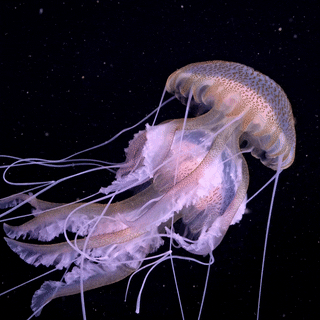
2 notes
·
View notes
Text
Last week on Wet Beast Wednesday I covered some of the biggest animals ever so this week I'm going to do a complete 180 and talk about the smallest animals in this series so far. Not so small as to be micro-animals (I'm sure I'll get to tardigrades eventually) but pretty small. Meet the hydra, a genus of freshwater cnidarians that can be found in temperate and tropical water worldwide. There's a lot of neat stuff about these tiny critters. Such as the fact that they're immortal, but we'll get to that in good time.

(image id: several hydras attached to a rock. Each hydra is a long, anrrow tube that branches at the top into 4 or more thin tentacles. They are milky-white in color. Source: Jan Hamrsky)
Hydras are visually similar to tiny anemones, but they're more closely related to siphonophores and jellyfish. Their bodies are pretty simple, consisting of a tubular body. On one end of the body is the basal disc, a simple foot that adheres to substrate. On the other end of the tube is the mouth, which leads into the gut. Ringing the mouth are tentacles that are covered in stinging cells. The gut is pretty simple and like other cnidarians, it doesn't go all the way through. That's right, when a hydra poops it comes out the same way it went in. A typical hydra consists of 50,000 to 100,000 cells and I hope for their sake that none of them are used for taste. Hydras are diploblastic, consisting of two layers of cells. For comparison, all vertebrates are triploblasts, with three cell layers. The hydra's layers are the epidermis on the outside and the gastrodermis making up the gut. Separating the layers is a gelatinous matrix called the mesoglea that functions as a hydrostatic skeleton. Hydras can contract their bodies and will do so if disturbed. When fully extended, they reach no longer than 10 mm (0.4 in). Hydras are in the cnidarian subphylum medusozoa. Other animals in this subphylum go through two stages of their lifecycle, a polyp that attaches to some substrate and a free-swimming medusa. In most, the polyp is a larval stage that will metamorphose into a medusa during maturation. Hydras instead stay as polyps their entire life. This could be a form of neoteny, the retention of juvenile traits into adulthood. Like other cnidarians, hydras are radially symmetrical. What is most impressive about hydras are their regenerative abilities.

(image id: a drawn diagram of a cross-section of a hydra with labeled anatomical features. source)
Hydras are masters of regeneration. It is this trait that earned them their name, a reference to the hydra of Greek mythology, who would grow two new heads whenever one was severed. Chop a hydra in half and each will grow into a new hydra. Chop a hydra into many pieces and you will get many hydras. Their regeneration is so impressive that if you chop one up into many cells and put them next to each other, the cells will reassemble themselves back into the original hydra. Similarly, hydras primarily reproduce asexually through budding, where one hydra will grow a new hydra out of its body. The daughter hydra will eventually split off from the parent and go on to live independently (unlike certain people I knew in high school). The daughter hydra is a genetic clone of the parent. A hydra living in good conditions can make a new clone every few days. In some species, sexual reproduction is also possible and usually only done when conditions are poor. Depending on the species, individuals can be either hermaphrodites or dioecious (either male or female). Gametes are released into the water to fertilize. Imagine if you wanted to make a baby and to do so you took a handfull of sperm or eggs and threw them all over the place, hoping that someone else also did the same thing in the right time and place. Broadcast spawning is weird.
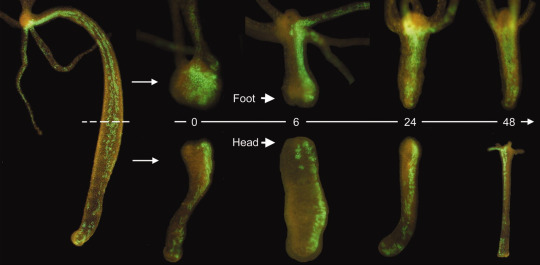
(image ID: photos of a hydra in the process of regeneration. The hydra is green. It is cut in half, creating a head and foot end. Additional photos taken over time show each end growing into a new hydra. source)
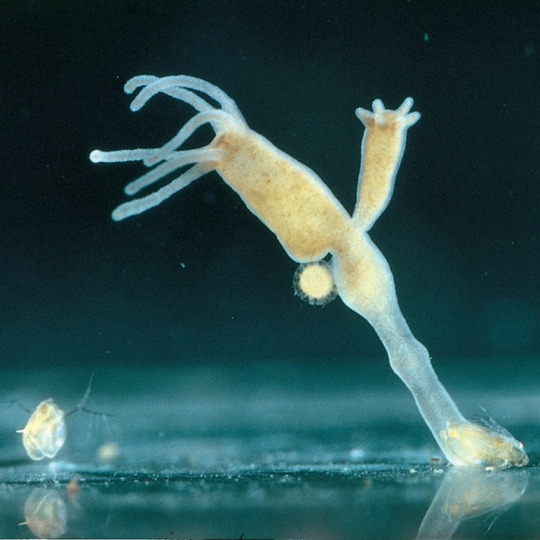
(image id: a pale white hydra growing a bud. the bud emerges from below the head and appears as a small tube. The head of the tube is branched into 5 small nubs that will grow into tentacles. )
Hydras are predators that feed on insect larvae, tiny invertebrates, and small enough fish larvae. They use their basal discs to attach to a hard surface like a rock or branch and extend their tentacles into the water. When something brushes against the tentacle, it triggers the stinging cells. These stinging cells are called nematocysts. Each nematocyst can release what is essentially a tiny harpoon that injects neurotoxin into the target. Nematocysts fire so fast that the harpoon can experience up to 40,000 Gs of pressure. Because nematocysts are tiny, an animal that touches a tentacle will be injected with venom from many of them, getting poisoned even more as they thrash about and get tangled up. The tentacle will then transfer the prey to the mouth. Hydras can swallow pretty large prey, expanding and contracting to fit the prey animal into them. It's kind of like a snake swallowing an egg bigger than its head. While typically sessile, hydras can move around. They can slither around on their basal discs, but when they need to move fast, they summersault. When summersaulting, a hydra will reach down and grab the ground with its tentacles. It then detaches the disc and moves it to a new position. This repeats until the hydra finds itself in a good spot. A speedy hydra can move a food few inches in a day. Hydras can also secrete gas bubbles from their basal discs to float around, upside-down, in the water. A hydra will usually only move from its spot in response to pressure such as predation, competition, or lack of food.
youtube
(video: a video of a hydra capturing and eating a mosquito larva. It starts with the mosquito touching a tentacle, which adheres to and stings it. Once the larva is dead, the hydra pulls it in and gradually engulfs it. Despite the larva being larger than the hydra, the hydra can stretch its body to fully swallow the mosquito)
So about that immortality thing. Yeah, it's not just that hydras can regenerate from just about anything, they also don't age. They're kind of like Tolkien's elves in that while they won't die on their own, they can be killed. No undying lands for hydras though. As far as we know. It has been found that hydra stem cells can infinitely renew the body, preventing the effects of aging. This means that a hydra living in a place with no threats could theoretically just keep going forever. They can still die due to predation, disease, starvation, poor environment, and all the other usual suspects. We actually know the gene sequence responsible for this. I tried to read up on it, but genetics is way over my head and it literally game me a headache trying to read. Along with their longevity, hydras also have an incredible ability to repair damage to their DNA. This is important as damage or mutations in DNA accumulate with age. This is why cancer is primarily a disease of old age. As damage accumulates past the body's ability to repair it, eventually a mutation that causes cancer will come along. The longer you live, the more time this mutation has to occur. The hydra's ability to repair its DNA keeps them from all inevitably getting cancer. Naturally, scientists are hugely interested in hydra regeneration, DNA repair, and immunity to aging. If we could figure out how these things work and apply them to humans it would be huge. Expanded, perhaps even indefinite life spans with reduced effects of aging are obvious, but there are other applications. Better DNA repair could vastly reduce the chances of getting cancer or other genetic conditions while regeneration could potentially allow people to regrow limbs or organs. This is obviously still in the realm of speculation, but it's exciting to think about. In conclusion, all hail our immortal overlords, the hydras.

(image id: a hydra growing on the shell of a dead snail. The hydra is a pale yellow color and contracted, causing its midsection to bulge out. A bud is growing from one side of it. Source: Jan Hamrsky)
#wet beast wednesday#hydra#hydra animal#hydrozoan#cnidarians#biology#zoology#ecology#freshwater ecology#freshwater biology#aquatic biology#biological immortality#immortality#regeneration#not like doctor who#Youtube
100 notes
·
View notes
Text
Round 2.5 - Cnidaria - Scyphozoa

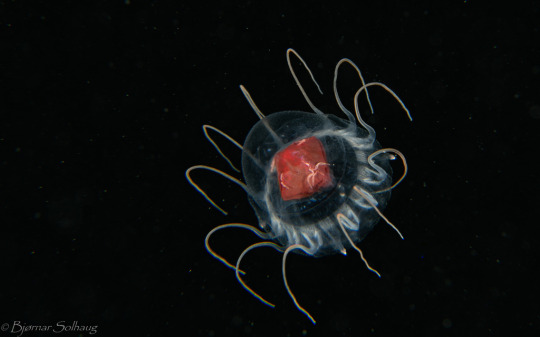
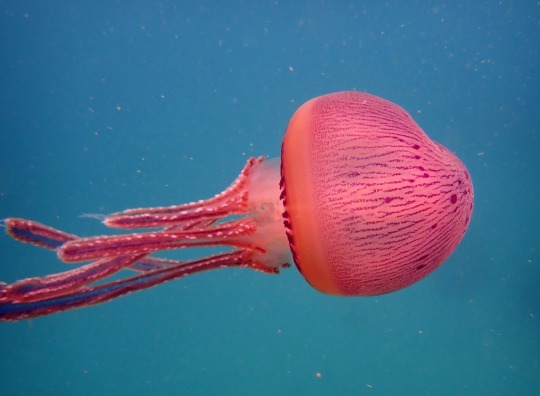

(Sources - 1, 2, 3, 4)
Scyphozoa is a marine class of cnidarians commonly referred to as “true jellyfish”, “jellyfish”, or simply “jellies”. They are composed of three living orders: Coronatae (“Crown Jellies”), Rhizostomeae (“Root-mouth Jellies”), Semaeostomeae (“Flag-mouth Jellies”).
Scyphozoans usually display a four-part symmetry and have an internal gelatinous material called mesoglea, consisting of as much as 98% water. A ring of muscle fibres within the mesoglea surrounds the rim of the dome, and the jellyfish swims by alternately contracting and relaxing these muscles. As medusae, they eat a variety of crustaceans and fish, which they capture using stinging cells called nematocysts. The nematocysts are located throughout the tentacles that radiate downward from the edge of the umbrella dome, and also cover the four or eight oral arms that hang down from the central mouth. Some species, however, are instead filter feeders, using their tentacles to strain plankton from the water. The mouth opens into a central stomach, from which four interconnected diverticula radiate outwards. Some genera also have smaller mouths in the oral arms. The lining of the digestive system includes further stinging nematocysts, along with cells that secrete digestive enzymes. The nervous system usually consists of a distributed net of cells, although some species possess more organised nerve rings. Some species also have pigment-cup ocelli, though they are not as advanced as Cubozoan eyes. Coronataens (ex: image 2) are characterized by a deep groove running around the umbrella, giving them the crown shape which gives them their name. Rhizostomeans (ex: image 1 and 3) do not have tentacles nor other structures branching off from the edges of the bell. Instead, they have eight highly branched oral arms which fuse together as they approach the central mouth of the jellyfish. Semaeostomeaens (ex: image 4 and gif below) have four long, frilly oral arms flanking their quadrate mouths, as well as tentacles.
Most species of Scyphozoa have two life-history phases, including the planktonic medusa or polyp form, and the inconspicuous, but longer-lived, bottom-dwelling polyp, which seasonally gives rise to new medusae. Most species appear to be gonochorists, with separate male and female individuals. The gonads are located in the stomach lining, and the mature gametes are expelled through the mouth. After fertilization, some species brood their young in pouches on the oral arms, but they are more commonly planktonic. The fertilized egg produces a planular larva which, in most species, quickly attaches itself to the sea bottom. The larva develops into the hydroid stage of the lifecycle, a tiny sessile polyp called a scyphistoma. The scyphistoma reproduces asexually, producing similar polyps by budding, and then either transforming into a medusa, or budding several medusae off from its upper surface via a process called strobilation. The medusae are initially microscopic and may take years to reach sexual maturity.
Scyphozoans have existed since the Early Cambrian.
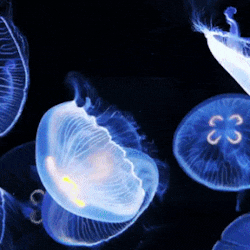
Propaganda under the cut:
The Lion’s Mane Jelly (Cyanea capillata) is one of the largest jellyfish, with the largest recorded specimen having a bell width of 210 cm (7 ft) and tentacles around 36.6 m (120 ft) long.
Jellyfish of the order Rhizostomeae are considered edible, both as a delicacy and for use in traditional medicine, and are eaten mainly in Asia, typically dried and/or salted.
The giant Nomura's Jellyfish (Nemopilema nomurai) can reach similar sizes to the Lion’s Mane Jellyfish, and their large size and quantity often negatively affects fisheries in East Asia. Aside from humans, their only predators are swordfish, tuna, sunfish, and leatherback sea turtles. A decrease in predators and an increase in favorable conditions and warming seas have caused an explosion in population, displaying that an increase in animal populations is not always a good sign! Scientists are studying their venom for use in medical applications, such as for treating joint disease and in cancer research. The Japanese company Tango Jersey Dairy also produces a vanilla and jellyfish ice cream using Nomura's Jellyfish.
While most jellies are exclusively marine, the Bay Nettle (Chrysaora chesapeakei) ventures into the Chesapeake Bay’s brackish water all the way up into the freshwater of Baltimore’s Inner Harbor.
The Giant Phantom Jelly (Stygiomedusa gigantea) is a deep sea jellyfish that is rarely seen, with only around 110 sightings in 110 years. It thought to be one of the largest invertebrate predators of the ocean's midnight zone and twilight zone, with an umbrella-shaped bell that can grow up to 1 m (3.3 ft) in diameter and paddle-like arms that can grow up to 10 m (33 ft) in length. The bell's pliant tissue allows for the jellyfish to stretch 4 to 5 times its size, presumably to engulf their prey. They do not have any stinging tentacles and instead use their arms to trap and engulf their prey which consists of plankton and small fish. The Giant Phantom Jelly has a symbiotic relationship with the Pelagic Brotula (Thalassobathia pelagica), for which it provides food and shelter beneath its massive billowing bell, while the fish aids the jelly by removing parasites.
The Mauve Stinger (Pelagia noctiluca) is a fairly small purple jellyfish that is able to glow in the dark (bioluminesce). Light is emitted in the form of flashes when the medusa is stimulated by turbulence created by waves or by a ship's motion. Unusually among cnidarians, Mauve Stingers are able to consume phytoplankton, alongside copepods and other usual planktonic fare.
The Moon Jelly (Aurelia aurita) (see gif above) is gaining popularity in aquarium touchtanks as they lack long tentacles and their sting has little to no affect on humans. They are also one of the longer-lived jellyfish, living up to two years in their medusa form, and are easy to rear and feed, making them a good candidate for giving humans an up-close learning experience with jellies.
Fun fact: my dad let me watch The Sphere (1998) when I was 7 and it gave me Scyphophobia, a fear of jellyfish, that lasted for several years. I knew the behavior of the jellyfish as depicted in the movie wasn’t real, but I still wouldn’t enter the ocean for the next 5 years, and when I did start entering the ocean again every time I saw a jellyfish I would get out and not go back in again for another full year. It took a touch tank and several positive experiences with some moon jellies to get over my fear, and now I would say I’m fully recovered!
99 notes
·
View notes